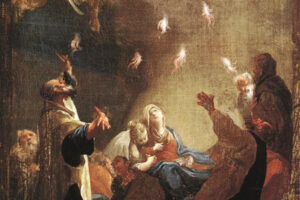‘One cannot solve the Jewish question without first solving the Christian Question’, said commenter Devan in the previous thread.
Isn’t it truly pathetic that, the only ones who want to defend the white race in the world, continue defending the religion that weakened the Aryan race against the Jews?
I recently said in this blog that we need to restore the WDH Radio Show in another platform to avoid further censorship. I’m not going to lie, but my original idea was to call that show ‘White Nationalist Critic’ precisely to expose, day by day, the pronouncements of those WNsts still circumscribed in the Judeo-Christian ethics that is killing the fair race.
To mention the case of my previous entry, Counter-Currents suffers a kind of ‘schizophrenia’, as Andrew Hamilton once said referring to this webzine of Greg Johnson (Hamilton had in mind the etymological sense of divided mind). Such divided self would be the central theme of what I wish to be the content of my radio show. But for this I need a regular collaborator to reopen that show with its original name, ‘White Nationalist Critic’.
Certainly, one cannot solve the Jewish Problem without first solving the Christian Problem. If the white race is extinguished, ours would be at least the testimony in the spoken word (besides the texts of this site) that denounces these pseudo-knights of the 14 words, unable to apostatize from Judeo-Christian ethics.
Below, an abridged translation of a passage from Karlheinz Deschner’s encyclopaedic history of the Church in 10-volumes, Kriminalgeschichte des Christentums. (For context read the translation of Volume I.)
______ 卐 ______
Hence, Augustine has harsh words about Greco-Roman shows when compared with Christian shows. Instead of being enthusiastic about the charioteer of the circus, we must turn our eyes to God, who, like a good charioteer, restrains, so to speak, human vices. Instead of admiring the tightrope walker, you have to put our eyes on Peter walking on the water. In a nutshell: instead of theatre and poetry, Augustine advises studying the Bible.
The greatest of the Fathers of the Church insulted as few did the Greco-Roman spectacles, even though he is the only one among them that also has positive words about them. Sometimes he casts true cataracts of repulsive reproaches against the shows of the adversaries. In a single passage of The City of God Against the Pagans Augustine harshly rebuked the celebration of a festive ceremony by Cicero to appease the gods.
Nonetheless, Augustine himself with conjuring arts also presented Christians with eternity as a wonderful spectacle. He sees radically eclipsed all the shows of the Hellenes by the spectaculum of the Last Judgment, by the universal apocalyptic theatre of the Christians. The tragic actors and the pantomime performers will represent the most calamitous of the roles in that last and unwanted performance.
What a spectacle for us, Tertullian says, will be the next coming of the Lord… What a spectacle will be the one that unfolds there! What things will provoke my admiration, my laughter? What will be the place of my joy, of my rejoicing? What would it be like to be able to see so many powerful kings there, who were said to have been admitted to heaven, to sigh in the depths of the darkness and justly accompanied by Jupiter and his witnesses?
How many procurators, persecutors of the name of the Lord will be consumed in flames more horrible than those with which they made atrocious derision of the Christians!
How will those wise philosophers burn in the company of their disciples who are persuaded that God does not take care of anything, to those who taught that we do not have a soul or that the soul will not return to the body at all—or in any case not to its anterior body!
Yes, how they will burn with their own students and ashamed at their sight!
What will it be like to see also the poets appear and tremble, against all foresight, before the tribunal of Christ and not before that of Rhadamanthus or of Minos?
And the tragic actors will then deserve to listen carefully to their ears, namely to listen to the lamentations for a misfortune that will be their own. It will be worthy to contemplate comedians even more weakened and softened by fire…
Contemplating things like that and rejoicing in them is something that neither praetors, consuls nor quaestors, nor even the priests of idolatry can offer you, no matter how generous their generosity. And, nevertheless, all these things are present in our spirit and, to a certain extent, we contemplate them already thanks to faith.









